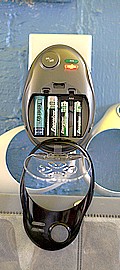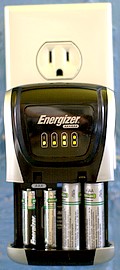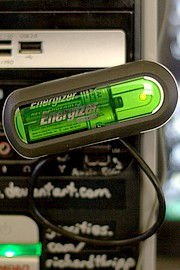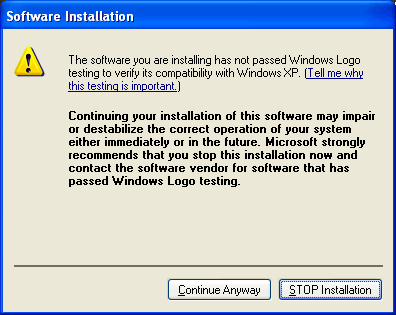


This is Energizer’s current lineup of budget AA/AAA battery chargers. I was fortunate enough to have Margaret Welch of Blick & Staff Communications send me these on Energizer’s behalf, and I’ve had plenty of time to try them out.
All three work with AA and AAA; with AAA, there are smaller contacts that flip down to accommodate the batteries’ smaller lengths. None of them are made for the forgetful person needing power for their camera at the last minute; to fully charge four 2500 mAh AA batteries, it takes 5 hours, 6.5 hours, or 8.5 hours (from left to right, respectively). However, if you rotate sets, or let them work overnight, these are perfect for use at home or when traveling. If you want a charger that works quickly, Energizer offers a 15-minute charger (Amazon.com), and it has a fan, so your batteries shouldn’t get too hot. I didn’t get one for this review, but customer opinion is positive.
From left to right, as labeled on the packages:
Energizer CHFM1: e2 Rechargeable
Energizer CHDC7: e2 Rechargeable Compact Charger AA/AAA
Energizer CHUSB: e2 Rechargeable USB Duo AA/AAA Charger
These newer chargers turn off automatically, not based just on a timer, but rather they detect when batteries are done, which extends the life of your investment.
In case you’re in the dark, you can use these to power any AA or AAA Nickel-metal hydride batteries, even if they are a different brand. This includes the new low-discharge variants, such as the Rayovac Hybrid brand.
My favorite of the three is the compact one (middle, CHDC7). The charging part retracts into the body, so you can throw it in your bag without wasting any space. The light indicators are innovative; when one is blinking, the charging is begun; when two are blinking, the it is past half way, and when two are solid, it is complete. This makes it easy to track the progress. Plus, it looks cool, and the charger isn’t as wide as the first. It took just over six hours to empower a fresh set of four Energizer-brand AAs, and I’ve taken over 300 shots with my Canon PowerShot A620, with no low-battery warning in sight. I don’t use the flash as I prefer ambient lighting; the batteries will drain faster if you do. Back in the stone age (a.k.a. 2005), I used Mattel’s Juice Box as my MP3 player; it uses three AA batteries, and I always hated that many chargers would only work in groups of two. This one is no different, unfortunately; you can only charge two or four batteries at once, not one or three. Two can be AAs and two can be AAAs, at least.
The Energizer CHFM1 (left) isn’t much different from the compact charger, except for being bulkier and slower (8.5 vs. 6.5 hours). It too charges batteries in groups of two. You can change the face plate; there is white, silver, and black, which is a nice touch. I like the black one, though the back is dark gray and doesn’t match. The only indicator light is red for charging and green for done; there is an on/off button, so that you can turn it off but leave it plugged in; I just unplug it, so I have no use for the button. One thing that worries me about both is that they have no extension cables, but instead have a plug that flips out, so if you plug them into a power strip they’ll block a lot of outlets, and they weigh a pound each with batteries, which puts stress on the outlet. If you’re using a regular wall outlet, it shouldn’t matter, and the simplified plug saves space.
The USB charger (right) touts itself as working in two hours, but actually needs five hours for Energizer’s current 2500 milliampere-hour AA batteries (mAh, generally a measurement of battery capacity). Don’t expect to restore your Fujifilm A900‘s two AA batteries from deadness before your laptop’s battery gives out, but you can get the boost needed for fifty shots if you have your laptop, and a half hour to kill, right in the field. The charger will power up a pair of AAA batteries in two hours, but no serious cameras use them because they drain so quickly. The Fujifilm and Canon A series cameras are still being made and all utilize AAs, though many of the Canons, such as my PowerShot A620, use four AAs, so this charger will be less practical. You can refill one battery at once if you choose, unlike with the others. I can see this being useful for my MP3 player/voice recorder, it being powered by one AAA. The charger also comes with a wall plug so you can use it in a standard U.S. power outlet, away from your computer. The USB cord is just six inches long; that saves space (the cord wraps around the body), but can be inconvenient.
A unique feature of the USB charger is that you can download software at http://energizer.com/usbcharger/ that displays how long you’ll have to wait. The software is available for Windows 2000 or Mac OS 10.4 and above; the Windows version is 3MB, occupies 13MB of space, and is non-portable (writes to the registry), so you can’t keep it on your USB flash drive. It adds a shortcut in “Programs” in your Start Menu AND at the top, which is overkill because the program starts automatically when you plug the charger into a USB port. When I was installing it, Windows XP gave this message:

It’s a pointless warning message, but will confuse many unexperienced Windows users.
Here’s what it looks like when the charger is plugged in but with no batteries:

And with a battery, the remaining time is displayed; 3 hours, 48 minutes here:

If you are charging 2 batteries, the time displayed is just that of the battery that will take the longest. The software is really basic; you can change the color (mine is orange, as you can see), and configure the software to start and terminate when you attach and detach the charger, but that’s all. I have no idea why Energizer UsbCharger.exe is 12.3MB, nor why it eats up 31MiB of RAM all the time, other than inefficient programming.
The left one (CHFM1) comes with 4 AA rechargeables, the middle with none (CHDC7), and the right (CHUSB) with 2 AAA rechargeables. I used the AAs from the first in the second, and they work great. They can be more expensive, but, if you’ve read my article, Simple Advice on AA Chargers & Batteries, you know the dangers of cheap, gray-market batteries. Energizer batteries always work well and last a long time, so I have no hesitation in recommending them. Plus, I have Duracell batteries where the labels peel off after some use, but this annoyance doesn’t crop up with Energizer, which is nice. All of Energizer’s new peripherals are good despite my gripes; I’m glad we’ve finally passed the age of timer-driven (or even timerless), “dumb” chargers that I’ve complained of. While AAs don’t last as long the Lithium-Ion battery in my Canon Rebel XTi, they’ve come quite far, are cheaper, and are far easier to find.

